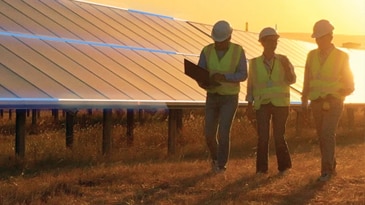As the energy transition accelerates, utilities are at the forefront of a profound transformation. The rapid expansion of distributed energy resources (DERs), including rooftop solar, battery storage, electric vehicles and smart appliances, is transforming the grid from a traditional centralized, one-way system into a dynamic, decentralized ecosystem. While this evolution brings tremendous opportunities for decarbonization and customer empowerment, it also introduces new complexities in maintaining grid reliability, visibility and control.
Enter FERC Order 901, a pivotal regulatory milestone that raises the bar for how transmission utilities must manage inverter-based resources (IBRs), the technological core of most DERs. And stepping up to meet this challenge is AspenTech OSI Distributed Energy Resource Management System™ (DERMS), a next-generation platform designed to orchestrate DERs with precision, intelligence and resilience.
What Is FERC Order 901?
The Federal Energy Regulatory Commission (FERC) issued Order 901, tasking the North American Electric Reliability Corporation (NERC) with developing new standards to enhance the performance of IBRs.In contrast to conventional spinning generators (natural gas and coal), which naturally contribute system inertia to the grid, IBRs lack this crucial stabilizing feature. System inertia acts like a shock absorber, buffering the grid against sudden changes in voltage or frequency by momentarily maintaining power flow. Without it, the grid becomes far more sensitive to imbalances and disturbances.
IBRs don’t inherently resist shifts in frequency or voltage. This absence of inertia reduces the grid’s ability to dampen fluctuations, increasing the likelihood of cascading failures or instability during disturbances.
To address this vulnerability, these new standards are being developed to ensure that transmission operators have visibility and awareness of IBRs on the network and their behavior during disturbances. This capability is vital to maintaining reliability and resilience in a power system that's rapidly evolving toward cleaner but less inertia-rich technologies.
FERC Order 901 emphasizes:
- Performance-based ride-through requirements
- Post-event performance validation
- Improved data sharing and model accuracy
- Disturbance monitoring and analytics
With implementation going into effect in 2030, utilities must begin preparing a digital strategy to comply with this standard now.
AspenTech OSI DERMS Supports FERC Order 901 Compliance
AspenTech OSI DERMS is purpose-built to help utilities navigate this new regulatory landscape. And it’s not just about compliance, it’s about building a smarter, more resilient grid.
Here’s how DERMS aligns with FERC Order 901:
- Data-Driven Decision Making: With robust data aggregation and visualization tools, utilities gain the insights needed to meet FERC’s data-sharing and monitoring requirements.
- Real-Time DER Coordination: During grid disturbances, AspenTech OSI DERMS enables dynamic control of DERs to maintain voltage and frequency stability.
- Advanced Analytics & Model Validation: AspenTech OSI DERMS supports post-event analysis and model tuning, helping utilities validate IBR performance against expected behavior.
- Scalable, Secure Architecture: Designed to evolve with NERC’s roadmap, AspenTech OSI DERMS can scale to support growing DER portfolios and increasingly complex grid conditions.
Why It Matters
With the growing presence of DERs, the grid faces increasing vulnerability. If IBRs fail to respond properly and system inertia continues to decline, the potential for widespread, cascading failures grows significantly.
FERC Order 901 requires utilities to deploy a comprehensive digital technology strategy that will not only meet the above capabilities but expand and grow as additional functionality is needed. Digital Grid Management is rising to the challenge, leveraging deep expertise, cutting-edge innovation, and an unwavering commitment to modernizing the grid for a more resilient energy future.
Powering Smarter Grids for the Future
AspenTech OSI DERMS equips utilities with advanced tools to manage DERs intelligently and proactively. This forward-thinking approach is helping shape a future power grid that isn’t just cleaner, but also stronger, more resilient, and better able to adapt to rapidly evolving demands.
Learn more about our AspenTech OSI DERMS software here.






Leave A Comment